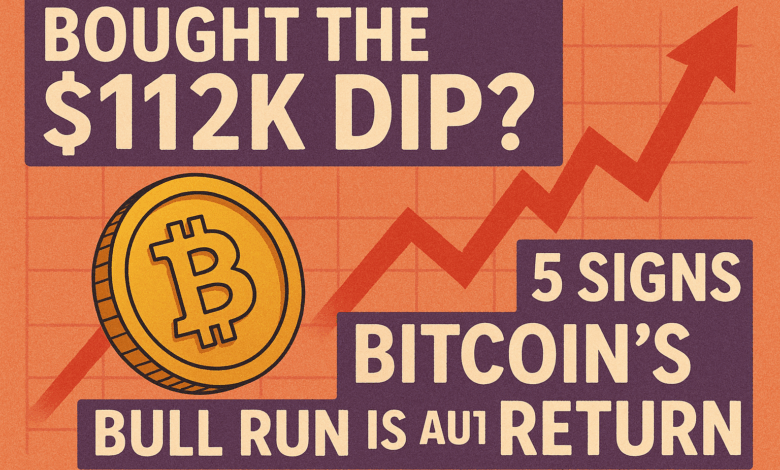Bought the $112K Dip? 5 Signs Bitcoin’s Bull Run Is About to Return

1. Introduction
When Bitcoin briefly dropped to $112,000, many investors saw it as a catastrophe—a sign that the party was over. But seasoned crypto veterans and contrarian investors saw something entirely different: an opportunity. In the volatile world of cryptocurrencies, dramatic price swings are not anomalies—they are features. Major dips often precede monumental rallies, and historically, periods of widespread fear have always been fertile ground for future wealth. In the case of Bitcoin, the recent correction might just be the prelude to the next bullish breakout. This article dives into five major signals pointing to why this dip may not be the end but the beginning of something much bigger for Bitcoin.
2. Overview of Bitcoin’s Historical Price Movements
To understand where Bitcoin is likely headed, it’s essential to examine where it’s been. Bitcoin’s price trajectory has always been cyclical, often driven by a complex interplay of market psychology, macroeconomic factors, and technological milestones. Since its inception in 2009, Bitcoin has experienced several epic bull runs followed by brutal corrections. In 2013, BTC surged to over $1,000, only to crash by more than 70%. The cycle repeated in 2017 when it soared to nearly $20,000, then collapsed to just over $3,000 in 2018. Yet each time, Bitcoin not only recovered but exceeded its previous all-time highs.
The 2020–2021 cycle took Bitcoin to an astonishing $69,000 before tumbling down to a low near $17,000 by the end of 2022. Fast forward to 2023–2024, Bitcoin’s rebound was swift, once again following its well-recognized boom and bust characteristics. The recent dip to $112K, while unnerving to some, comes after months of consistent growth. This kind of price action mirrors past patterns, where a sharp retracement clears out weak hands before a new accumulation and breakout phase begins.
History shows us that every bull run has four distinct phases: disbelief, hope, optimism, and euphoria. With the market now appearing to move from ‘hope’ to ‘optimism,’ there’s a strong indication that this correction could be part of that journey toward eventual market euphoria. The idea that Bitcoin could stage yet another massive leg up should not be dismissed as mere hype—it’s a pattern we’ve seen time and time again. Discover more on Bitcoin’s past boom-bust cycles in this detailed price history overview.
3. Technical Analysis of Bitcoin’s Current Position
From a technical standpoint, Bitcoin has displayed resilience. The $112,000 support level aligned perfectly with the 100-day moving average, a historically reliable support during uptrends. Even during consolidation phases, this level tends to attract significant buying pressure. Additionally, the RSI (Relative Strength Index) briefly entered oversold territory, further indicating a potential reversal was imminent. Oversold RSI levels often coincide with strong rebounds, particularly when accompanied by bullish divergence in momentum indicators.
Another important metric is the MACD (Moving Average Convergence Divergence), which is flashing bullish crossovers on daily and 4-hour charts. This suggests that momentum could soon shift back to the upside. Furthermore, Fibonacci retracement analysis places $112,000 within the coveted 0.618-0.65 “golden pocket” zone, historically one of the most significant buy zones for Bitcoin. Bouncing off this zone increases the probability that Bitcoin’s correction was healthy and potentially a launchpad for future gains.
If Bitcoin breaks above immediate resistance near $125,000 and sustains weekly closes above $130,000, it could pave the way for another explosive move. Institutional traders closely monitor these levels, and surpassing them may trigger algorithmic buys and hedge fund entries. For a deeper dive into key price targets and expert scenarios, check out our comprehensive Bitcoin price prediction analysis.
4. Market Psychology and Investor Sentiment
Markets often move not just on numbers but on emotion. Right now, fear is thick in the air—and that’s precisely when seasoned investors start buying. The Fear & Greed Index, a popular tool used to gauge market sentiment, has recently hovered in the “Fear” zone. Historically, every time this index dips into the 30s or lower, it coincides with local bottoms and major rally opportunities.
Social media buzz—or the lack thereof—also paints an insightful picture. During bull runs, crypto news dominates headlines and social media chatter is relentless. But in downtrends, interest wanes, tweets turn bearish, and the #BitcoinIsDead meme resurfaces. Ironically, these are the periods when some of the smartest capital quietly accumulates.
On-chain data shows increasing activity from large Bitcoin wallets, also known as whales. These accounts often act as market makers, and their accumulation suggests growing confidence in future price appreciation. Glassnode and other blockchain analytics platforms report decreasing exchange balances for Bitcoin, indicating that more coins are moving into cold storage—another bullish sign pointing to long-term conviction among top-tier holders.
5. External Factors Influencing Bitcoin’s Price
Beyond technicals and sentiment, macroeconomic and geopolitical factors also play a pivotal role in Bitcoin’s price momentum. One of the most significant developments in recent months has been the growing institutional and governmental acceptance of digital assets. In the United States, pro-crypto legislation is gradually gaining traction. The proposed Financial Innovation Act and the Clarity for Payment Stablecoins Act have created a more favorable regulatory environment, reducing uncertainty for investors.
Globally, financial centers such as Singapore, the UAE, and Hong Kong are crafting regulatory sandboxes and favorable tax incentives to attract blockchain companies and institutional investors. By facilitating clearer legal frameworks and fostering innovation, these jurisdictions are setting the stage for a new wave of adoption and capital inflow into the crypto ecosystem.
Institutional players are already responding. Investment giants like Fidelity, BlackRock, and Goldman Sachs are actively integrating digital assets into their product offerings. One of the most noteworthy catalysts is the rapid growth of spot Bitcoin ETFs in North America, which have opened up access to Bitcoin for both retail and institutional investors who prefer traditional investment vehicles.
And let’s not forget a recurring phenomenon that has historically signaled new all-time highs for Bitcoin—the halving. Scheduled for next year, the Bitcoin halving event will reduce block rewards from 6.25 BTC to 3.125 BTC. This supply reduction has, in every past cycle, initiated a new bull run within 6 to 12 months. With rising demand and dwindling new supply, the economics of scarcity could once again fuel a major rally.
6. Strategies for Investors
During high-volatility phases like the one we’re experiencing, having a clear investment strategy is more important than ever. One of the most time-tested methods is Dollar-Cost Averaging (DCA), where you invest a fixed amount at regular intervals. This minimizes the impact of short-term volatility and reduces emotional bias in decision-making.
Beyond DCA, strategic limit orders placed near historical support levels—such as $112K or $106K—can provide excellent entry points. Pair this with well-defined exit strategies using technical resistance levels like $145K, $165K, and potentially $180K. Always ensure you rebalance your portfolio to mitigate risk. Diversifying between Bitcoin and high-potential altcoins can potentially enhance returns, though Bitcoin remains the most risk-adjusted crypto asset for institutional investors.
Another smart approach is to maintain a “core and explore” portfolio. Designate a major portion of your holdings to blue-chip assets like Bitcoin (BTC), while using a smaller percentage to explore mid- and small-cap cryptocurrencies that could yield higher returns. Crucially, remember to keep a portion of your portfolio as a ‘moon bag’—an allocation you hold indefinitely in case of exponential upside. Always apply strong risk management principles and never invest more than you’re willing to lose.
7. Conclusion
The recent dip to $112,000 may eventually be seen not as a warning but as a winning signal—a moment of panic now recognized as a prime entry point. All the telltale signs of a potential breakout are aligning: historically bullish technicals, favorable macro trends, influential external catalysts, and a psychological climate ripe for contrarian accumulation. Whether you’re a long-term holder or an active trader, the current market landscape suggests one thing: the bulls aren’t gone; they’re just gathering strength for the next charge.
As always, keep your eyes on the long-term picture. Volatility will continue to be a constant companion in the crypto space, but with the right strategies and mindset, it can turn into your greatest ally. Do your own research, stay informed, manage risk wisely, and think beyond the noise of the moment. In the words of successful investors: fortune favors the bold—and more often than not, it favors the contrarians.
Source link





